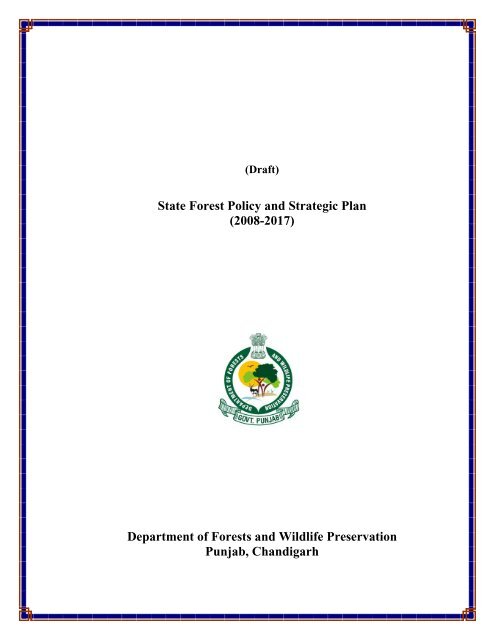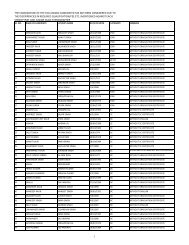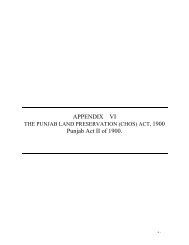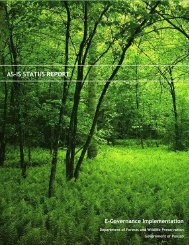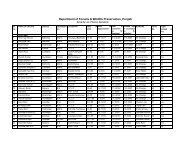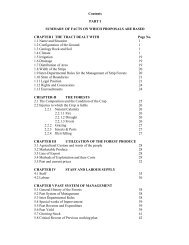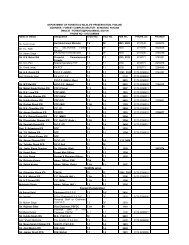Punjab Forest Policy(Draft) - Pbforests.gov.in
Punjab Forest Policy(Draft) - Pbforests.gov.in
Punjab Forest Policy(Draft) - Pbforests.gov.in
- No tags were found...
You also want an ePaper? Increase the reach of your titles
YUMPU automatically turns print PDFs into web optimized ePapers that Google loves.
(<strong>Draft</strong>)State <strong>Forest</strong> <strong>Policy</strong> and Strategic Plan(2008-2017)Department of <strong>Forest</strong>s and Wildlife Preservation<strong>Punjab</strong>, Chandigarh
PART I: THE POLICY1. Introduction<strong>Punjab</strong> <strong>Forest</strong> Department, one of the oldest State Departments, with aproud legacy, significant record of achievements, tradition of hard work is committed tothe cause of protect<strong>in</strong>g, conserv<strong>in</strong>g and enhanc<strong>in</strong>g State’s natural resource base andenvironment. The State was bifurcated <strong>in</strong> 1947 on partition of India and furthertrifurcatied <strong>in</strong>to <strong>Punjab</strong>, Haryana and Himachal Pradesh <strong>in</strong> 1966. Thus, <strong>Punjab</strong> has beenleft with smaller geographic area limited extent of forest resources. The <strong>Forest</strong>Department by mak<strong>in</strong>g all-out efforts to develop and enhance state’s forest resources hasbeen able <strong>in</strong>crease its forest area from 3.72% <strong>in</strong> 1966 to 6.3% at present.The Department has been s<strong>in</strong>cerely implement<strong>in</strong>g forestry programmes <strong>in</strong>accordance with the National <strong>Forest</strong> Policies of 1952 and 1988, Jo<strong>in</strong>t <strong>Forest</strong> Management(JFM) notification, 1990, and National <strong>Forest</strong>ry Action Programme (NFAP). To createsynergy among local, regional and national efforts to protect, conserve and manage forestresources on a susta<strong>in</strong>able basis, Government of India has urged the States to formulatetheir own forest policies <strong>in</strong> view of different sets of ecological, climatic, social-culturaland economic conditions prevail<strong>in</strong>g <strong>in</strong> each State.The State of <strong>Punjab</strong> is primarily agrarian with 84% of its area underagriculture with very high cropp<strong>in</strong>g <strong>in</strong>tensity. Also, urbanization and <strong>in</strong>dustrialisation aretak<strong>in</strong>g place at a very rapid pace <strong>in</strong> the State caus<strong>in</strong>g a negative <strong>in</strong>fluence on its naturalresources. All these activities are adversely affect<strong>in</strong>g the environmental quality of land,water and air, which need to be mitigated by mak<strong>in</strong>g suitable <strong>in</strong>terventions such asadopt<strong>in</strong>g environment-friendly technologies, Clean Development Mechanism (CDM),suitable agroforestry and tree farm<strong>in</strong>g models on agricultural lands for landusediversification, and green<strong>in</strong>g of community lands, <strong>in</strong>stitutional lands, Industrial estatesand urban areas, protection of heritage trees and old trees <strong>in</strong> rural areas.- 1 -- -
This policy provides a framework to identify and accommodate all theissues and pressures on forests and wildlife resources <strong>in</strong> the state and manage them toderive optimum environmental, social and economic benefits for the State and itsresidents. It describes the Government’s vision, mission and specific policy objectiveswhich will be adopted to manage the state’s forest resources <strong>in</strong> future.2. VisionThe State of <strong>Punjab</strong> shares the national vision of susta<strong>in</strong>able management offorests to meet the needs of present and future generations. This vision has follow<strong>in</strong>gcharacteristics:1. The total area under the forest and tree cover is <strong>in</strong>creased throughafforestation and landuse diversification.2. The forest resources are well protected and managed to reta<strong>in</strong> their<strong>in</strong>tegrity and biodiversity us<strong>in</strong>g modern technologies and scientificknowledge.3. The forest resources are managed <strong>in</strong> an eco-sensitive and susta<strong>in</strong>ablemanner to optimize all types of benefits to the society.4. <strong>Forest</strong> management is effective and responsive to the society, which has asound perception of importance of the State’s forests and participates <strong>in</strong>their protection and susta<strong>in</strong>able management.3. MissionTo achieve the State’s forestry vision, the mission of the Department of <strong>Forest</strong>sand Wildlife Preservation will be:• To <strong>in</strong>crease the area under forests and tree cover from present 6.3% to 15% ofthe State’s geographical area.• To protect, conserve and improve the State’s forests and other naturalresources for improv<strong>in</strong>g the quality of soil, air and water.- 2 -- -
• To practice susta<strong>in</strong>able forestry based on sound pr<strong>in</strong>ciples of susta<strong>in</strong>ableforest management through use of modern technologies and scientificknowledge.• To protect, conserve and enhance the wildlife and remnant biodiversityresources of the State by develop<strong>in</strong>g a suitable Protected Area Network.• To promote non-timber uses of forests such as eco-tourism, Non-Timber<strong>Forest</strong> Produce, medic<strong>in</strong>al plants and biodiversity.• To practice socially-<strong>in</strong>clusive forestry and solicit cooperation andparticipation of the rural and forest dependent communities and otherstakeholders <strong>in</strong> green<strong>in</strong>g the State.• To provide technical assistance, f<strong>in</strong>ancial <strong>in</strong>centives and extension services tothe people for promot<strong>in</strong>g social forestry, agroforestry and tree farm<strong>in</strong>g forlanduse diversification.• To implement Government policies and programmes by adopt<strong>in</strong>g <strong>in</strong>novativeapproaches for optimis<strong>in</strong>g social, economic and environmental benefits fromthe forestry sector to the state and its people.4. Basic Pr<strong>in</strong>ciples of <strong>Forest</strong> <strong>Policy</strong>4.1 The forest resources of the state are an environmental resource and not arevenue-earn<strong>in</strong>g source. Therefore the forest resources of the State need to be protected,conserved and enhanced for ga<strong>in</strong><strong>in</strong>g maximum environmental benefits for the society.To achieve this:- Utilize modern technologies to streaml<strong>in</strong>e the forestry adm<strong>in</strong>istration andscientific management of forests.- Apply scientific research and knowledge for improv<strong>in</strong>g vegetation coverand productivity of State <strong>Forest</strong>s.- Protect the exist<strong>in</strong>g forest areas through proper survey, demarcation andrais<strong>in</strong>g of appropriate boundary fenc<strong>in</strong>g, pillars or wall and trench as perlocal requirement- 3 -- -
- Undertake strong and effective management <strong>in</strong>terventions to fight themenace of encroachments at all levels.- Take effective steps to fight and stop heft and other illegal trade fromforests.4.2 To <strong>in</strong>crease the tree cover <strong>in</strong> the State from exist<strong>in</strong>g 6.3% to 15%. bypromot<strong>in</strong>g social and agro-forestry activities:- Encourage people’s participation <strong>in</strong> protection and management ofState’s forests and other natural resources.- Promote different models for agro-forestry and trees outside foreststhrough extension activities, technical assistance and f<strong>in</strong>ancial <strong>in</strong>centivesfor land-use diversification and improv<strong>in</strong>g the quality of soil, water andair for overall environmental improvement of the State.- promote environment friendly <strong>in</strong>dustry for utilis<strong>in</strong>g and process<strong>in</strong>g forestraw materials <strong>in</strong> manufactur<strong>in</strong>g of value added forest products.- Prescribe m<strong>in</strong>imum extent of area to be kept under tree plantation andvegetation cover by new <strong>in</strong>dustries, colonies, and <strong>in</strong>stitutions <strong>in</strong> the State.4.3 To protect, conserve and improve Wildlife biodiversity and geneticresources of the state by strengthen<strong>in</strong>g and expand<strong>in</strong>g the State’s ProtectedArea Network.- Fight illegal wildlife activities and trade through strong<strong>in</strong>terventions.- Revise State’s Protected Area Network to <strong>in</strong>clude all areasencompass<strong>in</strong>g remnant biodiversity of the State.- Coord<strong>in</strong>ate and <strong>in</strong>tegrate <strong>in</strong>-situ and ex-situ programmes forconservation of wildlife and biodiversity of the State.- Give special focus to protection and conservation of endangeredspecies of the state.- Institute a suitable <strong>in</strong>telligence-gather<strong>in</strong>g network to check crimeand illegal trade <strong>in</strong> wildlife.- 4 -- -
4.4 To promote empathy and sensitise people about importance of forestsand wildlife, biodiversity and environment through awareness,education, eco-tourism and extension activities.- Design a new forestry extension strategy for the State.- Promote ecotourism <strong>in</strong> wilderness areas with unique ecological values.- Institute awards to educational <strong>in</strong>stitute to <strong>in</strong>volve children <strong>in</strong> agreementof the state.- Run awareness campaigns to educate people almost environmentalbenefits of the forest and solicit their cooperative <strong>in</strong> green<strong>in</strong>g activities.4.5 Mitigate problems related to environmental degradation and climatechange through Clean Development & Mechanism (CDM) and carbonsequestration through afforestation and plantation activities.- Develop appropriate carbon sequestration methodologies foragroforestry plantations and get it approved from CDMAuthority.- Promote landuse diversification for reduction of harmfulgases from agricultural fields.- 5 -- -
PART II: THE STRATEGIC PLAN5. Strategic Approaches of <strong>Forest</strong> <strong>Policy</strong>5.1 Increase Area Under <strong>Forest</strong>s and Tree Cover• <strong>Punjab</strong> has 6.3% of its area under forests. The State has 84% of its area underagriculture with a very high cropp<strong>in</strong>g <strong>in</strong>tensity. Therefore, the State has set atarget to <strong>in</strong>crease area under forest and tree cover to 15% by 2017 under State<strong>Forest</strong>ry Action Programme. This can be achieved through agro-forestry on farmlands and by rais<strong>in</strong>g trees plantations on all k<strong>in</strong>ds of land <strong>in</strong> the State which maybe available for this purpose. Trees outside forests (TOF) should also be givendue importance as they have a major role <strong>in</strong> <strong>in</strong>creas<strong>in</strong>g the green cover of theState. An annual report of TOF (Species wise) can be obta<strong>in</strong>ed by mak<strong>in</strong>g it apart of the Revenue Gardawri System, so as to facilitate the actual groundtruth<strong>in</strong>gto achieve more realistic results from satellite imagery and GIS basedassessments.• In the Kandi Area, special steps <strong>in</strong>volv<strong>in</strong>g vegetative and eng<strong>in</strong>eer<strong>in</strong>g measuresshould be taken to prevent soil erosion, land degradation thereby ensur<strong>in</strong>g thestability of the fragile ecosystem of the Shiwalik Hills. Surface and sub-surfacewater harvest<strong>in</strong>g structures for ground water recharg<strong>in</strong>g and microlift irrigationschemes should be promoted to improve departmental support to localcommunities <strong>in</strong> provid<strong>in</strong>g them with irrigation facilities.• Water resources should be augmented <strong>in</strong> other parts of State as well by creat<strong>in</strong>gand renovat<strong>in</strong>g ponds and other water bodies, and undertak<strong>in</strong>g trees plantationsaround such structures, which should aim at recharg<strong>in</strong>g the underground watertable.• It is necessary to encourage the plant<strong>in</strong>g of trees alongside roads, railway l<strong>in</strong>es,rivers, dra<strong>in</strong>s and canals, and other unutilized/under utilized lands under state,corporate, <strong>in</strong>stitutional or private ownership. Green belts and pockets should beraised <strong>in</strong> residential and <strong>in</strong>dustrial areas as well as <strong>in</strong> the semi-arid tracts whichwill help <strong>in</strong> check<strong>in</strong>g erosion and desertification as well <strong>in</strong> as improv<strong>in</strong>g theenvironment.- 6 -- -
• A m<strong>in</strong>imum green cover policy should be framed for the <strong>in</strong>dustries, colonies,<strong>in</strong>stitutions and other projects be<strong>in</strong>g established <strong>in</strong> the State.• Green<strong>in</strong>g Action Plan for the State should be developed by <strong>in</strong>volv<strong>in</strong>g other StateDepartments manag<strong>in</strong>g land resources.• Village and community lands should be taken up for the development ofarboriculture and fodder resources. Technical assistance and other <strong>in</strong>centivesnecessary for <strong>in</strong>itiat<strong>in</strong>g such programs should be provided by the Government.The revenue generated under such program should be given to concernedPanchayats and communities `as an <strong>in</strong>centive to them and solicit their cooperationand participation.• Degraded forest areas near habitations should be regenerated with the cooperationand <strong>in</strong>volvement of local communities. Jo<strong>in</strong>t <strong>Forest</strong> Management practices shouldbe tuned to local scenario and adjusted to chang<strong>in</strong>g perceptions to achieve asusta<strong>in</strong>able green cover for the state.• Regulation for fell<strong>in</strong>g of the trees on private land and community hold<strong>in</strong>gs shouldbe reviewed and rationalized to enhance communities’ <strong>in</strong>terest <strong>in</strong> plant<strong>in</strong>g andprotect<strong>in</strong>g trees on their lands. The communities should also be provided withadequate f<strong>in</strong>ancial <strong>in</strong>centives for rais<strong>in</strong>g long-rotation tree crops dur<strong>in</strong>g the lock<strong>in</strong>period of their lands, which fall <strong>in</strong> eco-fragile or eco-sensitive areas.• Protection and preservation of Heritage trees and old trees <strong>in</strong> rural areas with thecooperation of local communities should be ensured.5.2 Management of the State <strong>Forest</strong>s• The permanent vegetation cover and productivity of state forestlands should be<strong>in</strong>creased through afforestation, enrichment and other methods.• <strong>Forest</strong>s <strong>in</strong> the State should be well protected and managed. These should besurveyed and demarcated by fix<strong>in</strong>g permanent boundaries.• All natural features and other structures of heritage, cultural or historicalimportance <strong>in</strong>side the forest areas should be identified and conserved.- 7 -- -
• There should be emphasis on multifunctional role of the natural forests and theirsusta<strong>in</strong>able management by formulat<strong>in</strong>g improved management plans us<strong>in</strong>gmodern technologies.• New technical manuals for all aspects such as management, plann<strong>in</strong>g, monitor<strong>in</strong>gand evaluation, and Wildlife Management should he prepared.• The exist<strong>in</strong>g <strong>Forest</strong> Manuals should he revised and updated.• Management plans and Work<strong>in</strong>g plans should be objectively written and strictlyfollowed for the forest areas covered under them and adequate f<strong>in</strong>ancial resourcesshould be earmarked for regeneration of harvested areas.• Scheme and projects that <strong>in</strong>terfere with forests on steep slopes, catchments ofrivers, lakes and reservoirs, and ecologically sensitive areas should be severelyrestricted.• Graz<strong>in</strong>g <strong>in</strong> the natural forests should be discouraged and feral population ofstrayed cattle controlled.• Soil and Water conservation works should be carried out wherever necessary toimprove the moisture regime of shiwaliks and augment the recharge andavailability of water resources.• Strip forests along roads, canals and dra<strong>in</strong>s should be managed as shelterbelts andrefuge for remnant biodiversity of the State and their frequent punctur<strong>in</strong>g throughdiversion of forestland should be discouraged.• Block forests <strong>in</strong> the pla<strong>in</strong>s should be cleared of <strong>in</strong>vasive alien species and restoredto <strong>in</strong>digenous vegetation of the area.• Illegal extraction of any type of forest produce or its illegal trade should betackled at all levels and stopped.• Local people and stakeholders should be closely associated with protection,regeneration and development of forests. Any agency <strong>in</strong>volved <strong>in</strong> forestmanagement should provide ga<strong>in</strong>ful employment to the people liv<strong>in</strong>g <strong>in</strong> andaround forests.• Only quality forest seedl<strong>in</strong>gs should be planted <strong>in</strong> afforestation and plantationprogrammes.- 8 -- -
5.3. Social <strong>Forest</strong>ry and Agro forestry• The requirements of the society should largely be met by development of forestand tree resources outside the Government forests.• Agroforestry besides offer<strong>in</strong>g environmental benefits offers an opportunity forcrop diversification and should be popularized among farmers.• Steps should be taken for <strong>in</strong>-situ propagation and conservation of medic<strong>in</strong>al plants<strong>in</strong> the Shiwaliks and other parts of the State.• Non-timber forest produce, its collection, regeneration, protection and market<strong>in</strong>gshould be <strong>in</strong>stitutionalized. Integrated development programmes should beundertaken to develop forest areas and their vic<strong>in</strong>ity to meet the needs of localpeople.• Provid<strong>in</strong>g Bio-energy as alternative source of energy should be one of the primeobjective of agroforestry and tree farm<strong>in</strong>g programmes under which short rotationenergy plantations should be taken.• Most appropriate Agro-forestry models <strong>in</strong>volv<strong>in</strong>g trees, agricultural crops and/ormedic<strong>in</strong>al herbs, shrubs and climbers should be encouraged. Individuals and<strong>in</strong>stitutions should also be motivated to undertake tree farm<strong>in</strong>g and grow fodderplants, grasses and medic<strong>in</strong>al plants on their own land.• Only high quality forest seedl<strong>in</strong>gs of fast grow<strong>in</strong>g species and those of colonalmaterial from certified nurseries should be made available to the farmers topromote agroforestry.5.4. Wildlife ConservationThe State <strong>gov</strong>ernment well strengthen and enhance the protected area network (PAN) toprotect and conserve its wildlife and biodiversity by constitut<strong>in</strong>g more protected areascover<strong>in</strong>g all the physiographic and climate zones of the State.• Each protected area should be effectively managed under an objectively writtenmanagement plan.- 9 -- -
• Illegal Trade <strong>in</strong> wildlife and wildlife products from with <strong>in</strong> the state and pass<strong>in</strong>gthrough the State should be strictly prevented.• Appropriate <strong>in</strong>telligence gather<strong>in</strong>g measures secret service fund and rewardscheme should be put <strong>in</strong> place to combat poach<strong>in</strong>g and illegal wildlife trade.• Mobility of staff and communication network should also be strengthened totackle wildlife crime.• Regular census/estimates of wild population of rare and endangered speciesshould be undertaken to monitor their status <strong>in</strong> the wild.• Habitat improvement programme such as Plantations <strong>in</strong> wildlife sanctuariesshould be undertaken only with <strong>in</strong>digenous species <strong>in</strong> l<strong>in</strong>e with the approvedmanagement plans after obta<strong>in</strong><strong>in</strong>g concurrence and sanction of the competentAuthority.• A Wildlife Atlas will be prepared to <strong>in</strong>ventorise and categorise the areas ofoccurrence of rare and endangered species so that effective strategies could be put<strong>in</strong> place to promote and conserve them.• Invasive alien species from <strong>in</strong>side and vic<strong>in</strong>ity of the protected areas should beremoved systematically to restore the <strong>in</strong>digenous flora and fauna. Strategies toachieve this task should be expressly described <strong>in</strong> management plans.• Conservation breed<strong>in</strong>g and planned breed<strong>in</strong>g programme should be undertaken bycoord<strong>in</strong>at<strong>in</strong>g <strong>in</strong>-situ and ex-situ conservation efforts of rare and endangeredspecies <strong>in</strong> the State.• Help of modern scientific knowledge, biotechnology and molecular biologyshould be taken <strong>in</strong> wildlife conservation programmes wherever deemed necessary.• For creat<strong>in</strong>g awareness among people about conservation of wildlife andbiodiversity Nature Education Programmes and camps should be organised <strong>in</strong>Sanctuaries, Parks and other protected areas. Nature Interpretation Centersshould be established for this purpose with adequate <strong>gov</strong>ernment fund<strong>in</strong>g.• Publicity and advertisement campaigns should be carried out to br<strong>in</strong>g variouswilderness areas rich <strong>in</strong> biodiversity and natural beauty <strong>in</strong>to focus and promoteecotourism.- 10 -- -
• Excessive use of pesticides is caus<strong>in</strong>g harm to the wildlife outside forestboundaries. Research on safer pesticides and fertilizers should be carried out andfarmers should be encouraged to use them through proper fund<strong>in</strong>g and extensionwork. The <strong>Forest</strong> Department <strong>in</strong> tandem with other Govt. agencies should alsoencourage organic farm<strong>in</strong>g and <strong>in</strong>tegrated pest management <strong>in</strong> agricultural areas.• Research work on various aspects of biodiversity conservation and improvementshould be carried out by <strong>in</strong>volv<strong>in</strong>g Universities and other Research Institutes5.5. Diversion of <strong>Forest</strong> Land for Non-<strong>Forest</strong> Purposes• Provisions of FCA. 1980 should be affective implemented especially to stopany violation along strip forests• Diversion of forestland especially from natural forest areas for any non forestpurpose should be considered as a last resort subject to carefully scrut<strong>in</strong>y.• Hazardous <strong>in</strong>dustrial development should be discouraged near forest areas andonly those <strong>in</strong>dustries should be allowed which are consistent with the pr<strong>in</strong>ciples offorest conservation.• Beneficiaries who are allowed m<strong>in</strong><strong>in</strong>g and quarry<strong>in</strong>g <strong>in</strong> forest land covered withtrees should be required to restore the degraded area with afforestation and to givea proper m<strong>in</strong>e management plan approved from the environmental angle.• The State has only 6.3% of its area under forests and this too is cont<strong>in</strong>uouslydiverted for <strong>in</strong>frastructure demands. To compensate the decrease <strong>in</strong> forestlandand to create new forest areas, land banks should be created <strong>in</strong> the State asreserves on surplus lands of the other State departments. The state should launcha scheme for purchas<strong>in</strong>g land for afforestation to improve the extent of forest andwildlife habitats <strong>in</strong> the State.5.6. Damage to <strong>Forest</strong> from Encroachment, Fires and Graz<strong>in</strong>g• Strong and effective management <strong>in</strong>terventions should be undertaken to fight themenace of encroachments <strong>in</strong> forests at all levels.- 11 -- -
• <strong>Forest</strong> areas should be cleared of all encroachments, and regularization of theencroachment should be strongly discouraged.• Special precautions should be taken dur<strong>in</strong>g the fire seasons and modernmanagement practices should be adopted to deal with forest fires. Fire fight<strong>in</strong>gtra<strong>in</strong><strong>in</strong>g should be imparted to forestry staff and local stake holders.• Graz<strong>in</strong>g <strong>in</strong> forest areas should be regulated <strong>in</strong> the Shiwalik with the <strong>in</strong>volvementof community by appropriately tra<strong>in</strong><strong>in</strong>g them. Young plantation and regenerationareas should be fully protected.• State should formulate a proper land use policy and domestic cattle managementstrategy.• Stray and feral population of animals such as cattle and dogs roam<strong>in</strong>g <strong>in</strong> theforests and protected areas should be controlled and where possible should betranslocated to gaushalas and other suitable facilities.5.7 Conservation and Propagation of Medic<strong>in</strong>al Plants• Herbal parks and Herbal Gian Kendras should be set up <strong>in</strong> each district to educatepeople about the traditional Indian System of medic<strong>in</strong>e for generat<strong>in</strong>g awareness,preserv<strong>in</strong>g the gene pool and production of quality seeds and seedl<strong>in</strong>gs fordistribution to the farmers.• Farmers should be encouraged for ex-situ cultivation and propagation ofmedic<strong>in</strong>al plants for <strong>in</strong>come generation. Enabl<strong>in</strong>g environment should be createdto facilitate process<strong>in</strong>g and market<strong>in</strong>g of medic<strong>in</strong>al plants and their products.• The <strong>Forest</strong> Department should take <strong>in</strong>itiative <strong>in</strong> grow<strong>in</strong>g and promot<strong>in</strong>g medic<strong>in</strong>alplants because most of the medic<strong>in</strong>al herbs are harnessed from the natural forestareas. Strategy for conservation, cultivation, market<strong>in</strong>g, evaluation of themedic<strong>in</strong>al plants should be <strong>in</strong>corporated <strong>in</strong> the management and Work<strong>in</strong>g plans ofthe forests.• State Medic<strong>in</strong>al Plants Board should be associated with State <strong>Forest</strong> Departmentfor s<strong>in</strong>cere and dedicated implementation of national policies <strong>in</strong> this regard.- 12 -- -
5.8. <strong>Forest</strong> Based Industry• Farmers should be encouraged to grow wood for better economic returns. Thereshould be no restriction and regulation on the fell<strong>in</strong>g of tree crops such asEucalyptus, Poplars and other fast grow<strong>in</strong>g species under agro forestry systems onprivate land hold<strong>in</strong>gs to encourage regular supply of raw materials to forest andwood based <strong>in</strong>dustries.• Industry should also be encouraged to raise forest raw material for its ownrequirement through contract tree farm<strong>in</strong>g with private landowners.• <strong>Forest</strong> based enterprise at the village or cottage level should be permitted onlyafter availability of raw material is periodically assessed.• All the wood based <strong>in</strong>dustries should be regulated through a proper frame workand illegal saw mills/<strong>in</strong>dustries should be closed.5.9. <strong>Forest</strong>ry Research• With <strong>in</strong>creased recognition of the role played by the <strong>Forest</strong>s <strong>in</strong> mitigat<strong>in</strong>genvironmental problems, biodiversity conservation and energy needs, emphasismust be laid on scientific forestry research by strengthen<strong>in</strong>g the research base aswell as identify<strong>in</strong>g new priorities for action.- Some priority areas of research and development can be identified as:- Increas<strong>in</strong>g productivity of wood/forest produce per unit forest area of theState.- Development of plantation models for revegetation ofbarren/marg<strong>in</strong>al/waste land/watersheds.- New approaches to social and community forestry for rural development.- Biotechnology and Tree improvement to produce quality seedl<strong>in</strong>gs formaximiz<strong>in</strong>g production from tree crops.- Optimum Soil and Water conservation practices to m<strong>in</strong>imize water runoff.- Protected Area Network models for wildlife and Biodiversity conservationand Management.- 13 -- -
- Research on Medic<strong>in</strong>al properties of medic<strong>in</strong>al plants and other forestproduce.- Control and management of <strong>in</strong>vasive alien species <strong>in</strong> forest areas.- Impact of climate change on forest productivity and tree crops <strong>in</strong> the State.• Collaborative Research <strong>in</strong>volv<strong>in</strong>g specialist <strong>in</strong>stitutes should be undertaken onpriority areas of forestry research.• Appropriate methodologies and models for holistic economic valuation of theforests and wildlife resources of the State should be developed which take <strong>in</strong>toaccount both tangible and <strong>in</strong>tangible benefits of the forests.• The holistic economic valuation should be used to develop a <strong>Forest</strong> ResourceAccount which would provide an accurate picture about contribution of forestrysector <strong>in</strong> the State Economy vis-a-vis other sectors.5.10. <strong>Forest</strong> Extension• A suitable forestry extension strategy should be formulated for the State underwhich a <strong>Forest</strong>ry Extension Network should be created to adequately meet theextension needs throughout the State.• <strong>Forest</strong> Conservation programme cannot succeed without the active cooperationand support of people. They should be <strong>in</strong>volved <strong>in</strong> development andconservation of forests, wildlife and natural resources. Assistance from<strong>in</strong>stitutions such as Krishi Vikas Kendras and Educational Institutions should alsobe taken <strong>in</strong> provid<strong>in</strong>g forestry extension support.• There should be separate regulated timber markets <strong>in</strong> the State by <strong>Punjab</strong> MandiBoard for ensur<strong>in</strong>g transparency <strong>in</strong> transaction and avoid<strong>in</strong>g exploitation of treegrowers.• Market <strong>in</strong>telligence and <strong>in</strong>formation gather<strong>in</strong>g mechanism shall be strengthenedfor the benefit of the tree growers and wood consumers.• Formation of tree grower’s cooperative should be encouraged.• Van Chetana Kendras should be established by the forest department <strong>in</strong> eachdistrict for extension activities. Education on nursery techniques, agroforestry- 14 -- -
and market<strong>in</strong>g of forest produce, medic<strong>in</strong>al plants and their market<strong>in</strong>g should beprovided by these Van Chetna Kendras.• Van Mitra Award scheme should be <strong>in</strong>stituted for educational <strong>in</strong>stitutions to<strong>in</strong>volve and encourage. school children is green<strong>in</strong>g of the State.• Regular awareness campaigns should be undertaken to educate people about theenvironmental, social and economic benefits of the forests and need to protect andconserve them.• Ecotourism should be used as a management tool for forest conservation. Sitesshould be identified <strong>in</strong> natural forests to develop them as Eco –Tourism spots, forthe exposure of people and connect<strong>in</strong>g them to the nature and its bounties withoutdisturb<strong>in</strong>g the ecology of the forest area. Some selected Shiwalik forests andwetlands should be developed for such purpose with the <strong>in</strong>volvement of villageforest committees so that the villagers are also benefited economically from suchactivity. Also, they will get encouragement to protect and develop their forestareas for such purposes. Community based Eco-rural tourism should be promotedon the fr<strong>in</strong>ges of the forests.• Due representation to forest officers at senior level should be given <strong>in</strong> differentl<strong>in</strong>e departments particularly State Environment Department and <strong>Punjab</strong> PollutionControl Board so that forest and environment development issues can beaddressed <strong>in</strong> an <strong>in</strong>tegrated manner to curb pollution and protect the environmentof the State.5.11. Application of Information Technology to <strong>Forest</strong>ry• Information technology should be made an <strong>in</strong>tegral part of forest management andplann<strong>in</strong>g.• Use of GIS-based <strong>Forest</strong> Management Information System (FMIS) should beencouraged to strengthen e-Governance <strong>in</strong> State <strong>Forest</strong> Department.• The exist<strong>in</strong>g staff should be adequately tra<strong>in</strong>ed <strong>in</strong> IT and FMIS, and whererequired, new staff should be recruited and posted to handle the critical areas ofIT-based activities such as GIS, MIS, RDBMS, and Network<strong>in</strong>g etc.- 15 -- -
• Use of spatial technologies such as GIS, GPS and Remote Sens<strong>in</strong>g should bepromoted among the field staff to draw maximum benefits from their use <strong>in</strong> forestmanagement, plann<strong>in</strong>g, monitor<strong>in</strong>g and evaluation, and decision support.• The department should aim at achiev<strong>in</strong>g 100% computer literary by tra<strong>in</strong><strong>in</strong>g bothm<strong>in</strong>isterial and field staff.5.12. F<strong>in</strong>ancial, Legal and Infrastructure Support to the <strong>Forest</strong> <strong>Policy</strong>.• A State <strong>Forest</strong>ry Board on l<strong>in</strong>es of State Board for Wildlife under theChairmanship of Chief M<strong>in</strong>ister, <strong>Punjab</strong> should be established to monitorimplementation of forest policy periodically and provide guidance to theDepartment.• Legal cells should be established to provide legal assistance to forestry staff atSub-Division, District and State level to take care of pend<strong>in</strong>g litigation.• The forestry sector which ma<strong>in</strong>ta<strong>in</strong>s the ecology, environment, and renewablenatural resources such as forests, wildlife and biodiversity soil and water for thefuture use should to be provided with adequate f<strong>in</strong>ancial resources to achieve itsmission.• For effective implementation of this policy, <strong>Forest</strong> Department should beprovided with appropriate <strong>in</strong>frastructure support <strong>in</strong> terms of mobility,communication and scientific equipment.5.13. Personnel Management, Education and Tra<strong>in</strong><strong>in</strong>g• Government policies on personnel management <strong>in</strong> forestry sector should aim atattract<strong>in</strong>g and reta<strong>in</strong><strong>in</strong>g qualified and motivated personnel and enhanc<strong>in</strong>g theirprofessional skills, competence and status.• S<strong>in</strong>ce the forest and wildlife staff performs multifarious duties and thus have todon many caps which <strong>in</strong>clude polic<strong>in</strong>g, developmental and scientific to name afew. The polic<strong>in</strong>g and protection of forests and wildlife is a prime duty of theforesters. It is imperative that facilities and privileges at par with police- 16 -- -
officers/personnel of correspond<strong>in</strong>g rank and pay is provided to the forestofficers/personnel.• The State should also open <strong>Forest</strong> Stations on the l<strong>in</strong>es of Police Stations.• Cadre Strength of <strong>Forest</strong> Officers of various ranks should be ma<strong>in</strong>ta<strong>in</strong>ed atoptimum level and reviewed every five years.• There should be lateral opportunities for forest officers to share experience withother departments to contribute to the development and progress of the State.• Capacity build<strong>in</strong>g of local people especially the members of Village <strong>Forest</strong>Committee (VFC), <strong>Forest</strong> Protection Committee (FPC) or Eco DevelopmentCommittee (EDC) should form an <strong>in</strong>tegral part of the Human ResourceDevelopment (HRD) Strategy of the State.• Tak<strong>in</strong>g <strong>in</strong>to account the latest developments <strong>in</strong> forestry and related discipl<strong>in</strong>es,specialized tra<strong>in</strong><strong>in</strong>g courses for develop<strong>in</strong>g better management skills for <strong>in</strong>serviceofficials needs to be encouraged. Government of India is alreadyconduct<strong>in</strong>g compulsory Tra<strong>in</strong><strong>in</strong>g Courses <strong>in</strong> various discipl<strong>in</strong>es for IFS officersevery year. State <strong>Forest</strong> Service Officers and all other forest officials of thedepartment should also be given tra<strong>in</strong><strong>in</strong>g <strong>in</strong> latest developments <strong>in</strong> forestry andmodern technologies.• A State <strong>Forest</strong>ry Tra<strong>in</strong><strong>in</strong>g Institute should be developed by equipp<strong>in</strong>g it with awell tra<strong>in</strong>ed faculty and good tra<strong>in</strong><strong>in</strong>g facilities for tra<strong>in</strong><strong>in</strong>g foresters and wildlifestaff as well as staff of other l<strong>in</strong>e-departments. A small cadre of non-foresters<strong>in</strong>clud<strong>in</strong>g Scientists, Ecologists, Geneticists, Sociologist, Economists, Legalexperts, Veter<strong>in</strong>arians and IT professionals should be provided to the <strong>Forest</strong>Department for address<strong>in</strong>g the natural resource management issues <strong>in</strong> a moreholistic manner.• The field staff of the <strong>Forest</strong> Department should be encouraged to developspecialization <strong>in</strong> modern technology applications <strong>in</strong> forestry and also secondaryspecialization through small tra<strong>in</strong><strong>in</strong>g modules <strong>in</strong> the fields like environmentalmanagement, horticulture, agriculture and other allied discipl<strong>in</strong>es.• An appropriate protocol should be ensured for I.F.S. officers as members of AllIndia Services. They should be given due position and protocol at District,- 17 -- -
Division and State Level meet<strong>in</strong>gs and functions commensurate with their statusvis-à-vis their counter parts from the other All India Services.• The fleet strength of the Department should be reviewed and upgraded from timeto time. In view of emergency nature of duties, vehicles of forests officers at thelevel of DCF’s and above should be provided with red light/flag. The field staffshould be provided with patroll<strong>in</strong>g vehicles/motorcycles. Also, mobilecommunication facility should be provided to each officer/official work<strong>in</strong>g <strong>in</strong> theDepartment.6. Epilogue• It is envisaged that this policy should lead to better forest management programsand practices which ensure environmental stability, promote conservation ofbiodiversity and bio-cultural heritage, and fulfill basic requirements of forestdependent and rural poor, and other stakeholders while maximiz<strong>in</strong>genvironmental, social and economic benefits for the State.********- 18 -- -


